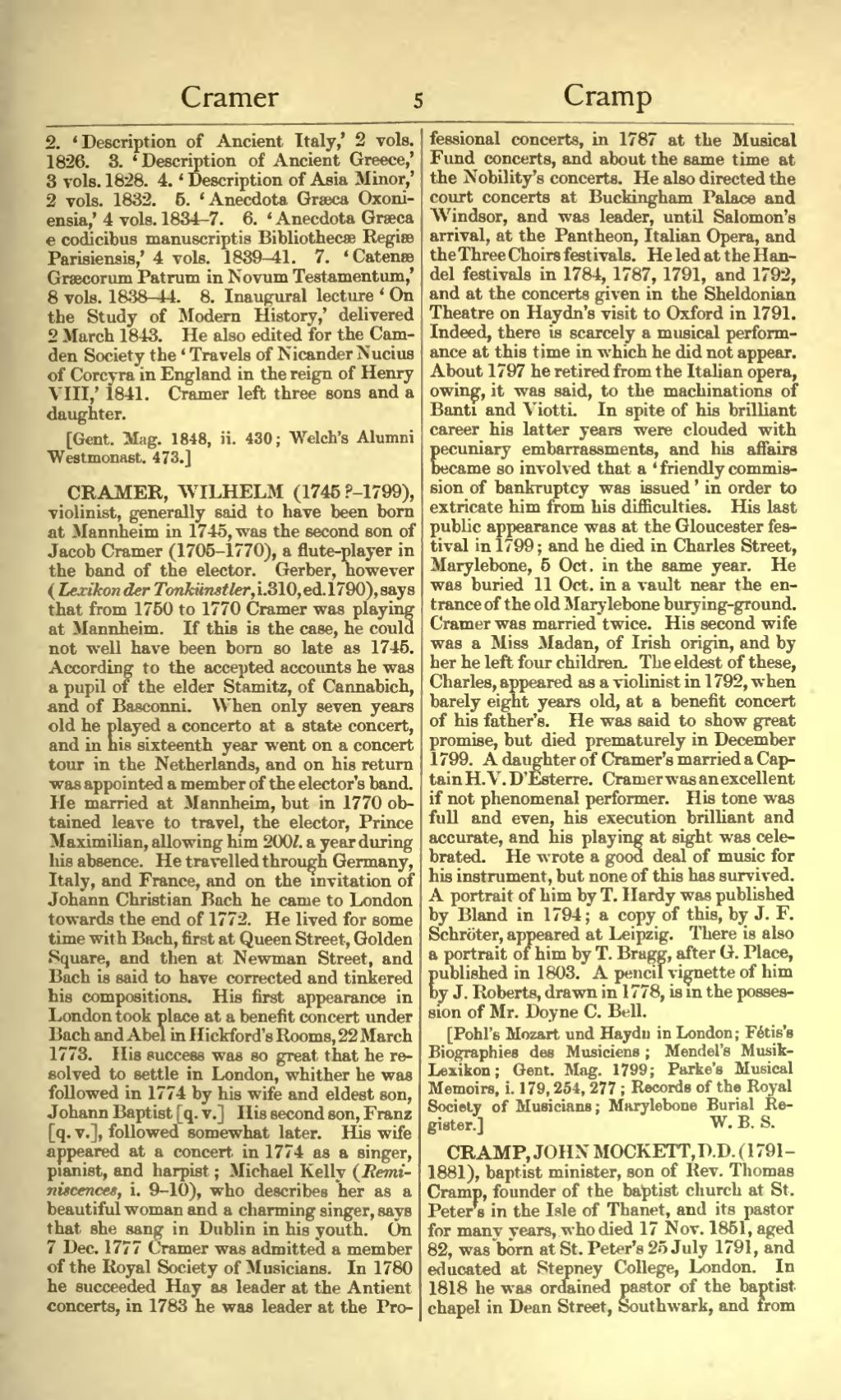2. ‘Description of Ancient Italy,’ 2 vols. 1826. 3. ‘Description of Ancient Greece,’ 3 vols. 1828. 4. ‘Description of Asia Minor,’ 2 vols. 1832. 5. ‘Anecdota Græca Oxoniensia,’ 4 vols. 1834–7. 6. ‘Anecdota Græca e codicibus manuscriptis Bibliothecæ Regiæ Parisiensis,’ 4 vols. 1839–41. 7. ‘Catenæ Græcorum Patrum in Novum Testamentum,’ 8 vols. 1838–44. 8. Inaugural lecture ‘On the Study of Modern History,’ delivered 2 March 1843. He also edited for the Camden Society the ‘Travels of Nicander Nucius of Corcyra in England in the reign of Henry VIII,’ 1841. Cramer left three sons and a daughter.
[Gent. Mag. 1848, ii. 430; Welch's Alumni Westmonast. 473.]
CRAMER, WILHELM (1745?–1799), violinist, generally said to have been born at Mannheim in 1745, was the second son of Jacob Cramer (1705–1770), a flute-player in the band of the elector. Gerber, however (Lexikon der Tonkünstler, i. 310, ed. 1790), says that from 1750 to 1770 Cramer was playing at Mannheim. If this is the case, he could not well have been born so late as 1745. According to the accepted accounts he was a pupil of the elder Stamitz, of Cannabich, and of Basconni. When only seven years old he played a concerto at a state concert, and in his sixteenth year went on a concert tour in the Netherlands, and on his return was appointed a member of the elector's band. He married at Mannheim, but in 1770 obtained leave to travel, the elector, Prince Maximilian, allowing him 200l. a year during his absence. He travelled through Germany, Italy, and France, and on the invitation of Johann Christian Bach he came to London towards the end of 1772. He lived for some time with Bach, first at Queen Street, Golden Square, and then at Newman Street, and Bach is said to have corrected and tinkered his compositions. His first appearance in London took place at a benefit concert under Bach and Abel in Hickford's Rooms, 22 March 1773. His success was so great that he resolved to settle in London, whither he was followed in 1774 by his wife and eldest son, Johann Baptist [q. v.] His second son, Franz [q. v.], followed somewhat later. His wife appeared at a concert in 1774 as a singer, pianist, and harpist; Michael Kelly (Reminiscences, i. 9–10), who describes her as a beautiful woman and a charming singer, says that she sang in Dublin in his youth. On 7 Dec. 1777 Cramer was admitted a member of the Royal Society of Musicians. In 1780 he succeeded Hay as leader at the Antient concerts, in 1783 he was leader at the Professional concerts, in 1787 at the Musical Fund concerts, and about the same time at the Nobility's concerts. He also directed the court concerts at Buckingham Palace and Windsor, and was leader, until Salomon's arrival, at the Pantheon, Italian Opera, and the Three Choirs festivals. He led at the Handel festivals in 1784, 1787, 1791, and 1792, and at the concerts given in the Sheldonian Theatre on Haydn's visit to Oxford in 1791. Indeed, there is scarcely a musical performance at this time in which he did not appear. About 1797 he retired from the Italian opera, owing, it was said, to the machinations of Banti and Viotti. In spite of his brilliant career his latter years were clouded with pecuniary embarrassments, and his affairs became so involved that a ‘friendly commission of bankruptcy was issued’ in order to extricate him from his difficulties. His last public appearance was at the Gloucester festival in 1799; and he died in Charles Street, Marylebone, 5 Oct. in the same year. He was buried 11 Oct. in a vault near the entrance of the old Marylebone burying-ground. Cramer was married twice. His second wife was a Miss Madan, of Irish origin, and by her he left four children. The eldest of these, Charles, appeared as a violinist in 1792, when barely eight years old, at a benefit concert of his father's. He was said to show great promise, but died prematurely in December 1799. A daughter of Cramer's married a Captain John D'Esterre. Cramer was an excellent if not phenomenal performer. His tone was full and even, his execution brilliant and accurate, and his playing at sight was celebrated. He wrote a good deal of music for his instrument, but none of this has survived. A portrait of him by T. Hardy was published by Bland in 1794; a copy of this, by J. F. Schröter, appeared at Leipzig. There is also a portrait of him by T. Bragg, after G. Place, published in 1803. A pencil vignette of him by J. Roberts, drawn in 1778, is in the possession of Mr. Doyne C. Bell.
[Pohl's Mozart und Haydn in London; Fétis's Biographies des Musiciens; Mendel's Musik-Lexikon; Gent. Mag. 1799; Parke's Musical Memoirs, i. 179, 254, 277; Records of the Royal Society of Musicians; Marylebone Burial Register.]
CRAMP, JOHN MOCKETT, D.D. (1791–1881), baptist minister, son of Rev. Thomas Cramp, founder of the baptist church at St. Peter's in the Isle of Thanet, and its pastor for many years, who died 17 Nov. 1851, aged 82, was born at St. Peter's 25 July 1791, and educated at Stepney College, London. In 1818 he was ordained pastor of the baptist chapel in Dean Street, Southwark, and from
